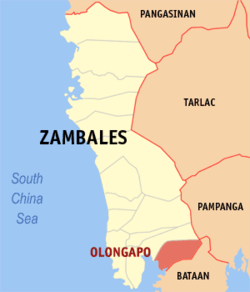Olongapo | |
|---|---|
| City of Olongapo | |
From top, left to right: Business district in Olongapo, Ulo ng Apo Monument, City Hall, Harbor Point (Subic), SM City Olongapo Central | |
| Nickname: | |
| Motto(s): Transparency and Good Governance[3] | |
| Anthem: Himno ng Olongapo (Hymn of Olongapo) | |
 Map of Central Luzon with Olongapo highlighted | |
Location within the Philippines | |
| Coordinates: 14°50′N 120°17′E / 14.83°N 120.28°E | |
| Country | Philippines |
| Region | Central Luzon |
| Province | Zambales (geographically only) |
| District | 1st district |
| Founded | November 4, 1750 |
| Cityhood | June 1, 1966[4] |
| Highly urbanized city | December 7, 1983 |
| Barangays | 17 (see Barangays) |
| Government | |
| • Type | Sangguniang Panlungsod |
| • Mayor | Rolen C. Paulino, Jr. |
| • Vice Mayor | Aquilino Y. Cortez Jr. |
| • Representative | Jefferson F. Khonghun |
| • City Council | Members |
| • Electorate | 123,707 voters (2022) |
| Area | |
| • City | 185.00 km2 (71.43 sq mi) |
| • Metro | 472.16 km2 (182.30 sq mi) |
| Elevation | 34 m (112 ft) |
| Highest elevation | 1,281 m (4,203 ft) |
| Lowest elevation | 0 m (0 ft) |
| Population (2020 census)[7] | |
| • City | 260,317 |
| • Density | 1,400/km2 (3,600/sq mi) |
| • Metro | 337,811 |
| • Metro density | 720/km2 (1,900/sq mi) |
| • Households | 66,450 |
| Demonym(s) | Olongapeño (masculine) Olongapeña (Feminine) Olongapenean |
| Economy | |
| • Income class | 1st city income class |
| • Poverty incidence | 7.60 |
| • Revenue | ₱ 1,731 million (2020), 655.7 million (2012), 916.7 million (2013), 1,123 million (2014), 1,246 million (2015), 125.8 million (2016) |
| • Assets | ₱ 10,149 million (2020), 6,501 million (2012), 6,366 million (2013), 7,091 million (2014), 6,988 million (2015), 7,554 million (2016) |
| • Expenditure | ₱ 1,328 million (2020), 885.6 million (2012), 1,010 million (2013), 807.5 million (2014) |
| • Liabilities | ₱ 7,291 million (2020), 4,310 million (2012), 4,277 million (2013), 6,504 million (2014), 659.9 million (2015), 6,696 million (2016) |
| Service provider | |
| • Electricity | Olongapo Electricity Distribution Company (OEDC) |
| ZIP code | 2200, 2222 (Subic Special Economic and Freeport Zone) |
| PSGC | |
| IDD : area code | +63 (0)47 |
| Native languages | Tagalog Ilocano Sambal Kapampangan Ambala |
| Website | www |
Olongapo ([ʔoˌloːŋ.ɡɐˈpo]), officially the City of Olongapo (Filipino: Lungsod ng Olongapo; Ilocano: Siudad ti Olongapo; Sambal: Siyodad nin Olongapo; Kapampangan: Lakanbalen/Ciudad ning Olongapo), is a 1st class highly urbanized city in the Central Luzon region of the Philippines. According to the 2020 census, it has a population of 260,317 people.[7]
It is geographically situated and grouped under the province of Zambales by the Philippine Statistics Authority but governed independently from the province and it is also the largest city. Portions of the city also form part of the Subic Special Economic and Freeport Zone.
Along with the municipality of Subic, it comprises Metro Olongapo, one of the twelve metropolitan areas in the Philippines.[9]
- ^ "AUICK Newsletter No.54 AUICK News". Asian Urban Information Center of Kobe. 2010. Archived from the original on April 14, 2019. Retrieved April 14, 2019.
The City Council of Olongapo recently passed an ordinance adopting the title "City of Volunteers" for Olongapo City, to reflect its strong community-based volunteerism.
- ^ Songco, Pauline (August 13, 2018). "Gift of a legacy". Daily Tribune. Archived from the original on August 15, 2018. Retrieved April 14, 2019.
- ^ "Intense race to City Hall in Olongapo". The Manila Times. February 2, 2016. Archived from the original on July 11, 2018. Retrieved April 14, 2019.
Paulino, on the other hand, is banking on his growing popularity as a friendly, easy to approach city mayor and his slogan "Transparency and Good Governance" to extend his stay as the city's chief executive.
- ^ Cite error: The named reference
tripodwas invoked but never defined (see the help page). - ^ City of Olongapo | (DILG)
- ^ "2015 Census of Population, Report No. 3 – Population, Land Area, and Population Density" (PDF). Philippine Statistics Authority. Quezon City, Philippines. August 2016. ISSN 0117-1453. Archived (PDF) from the original on May 25, 2021. Retrieved July 16, 2021.
- ^ a b Census of Population (2020). "Region III (Central Luzon)". Total Population by Province, City, Municipality and Barangay. Philippine Statistics Authority. Retrieved July 8, 2021.
- ^ "PSA Releases the 2021 City and Municipal Level Poverty Estimates". Philippine Statistics Authority. April 2, 2024. Retrieved April 28, 2024.
- ^ "Building Globally Competitive Metro Areas in the Philippines" (PDF). Archived from the original (PDF) on October 4, 2013.








